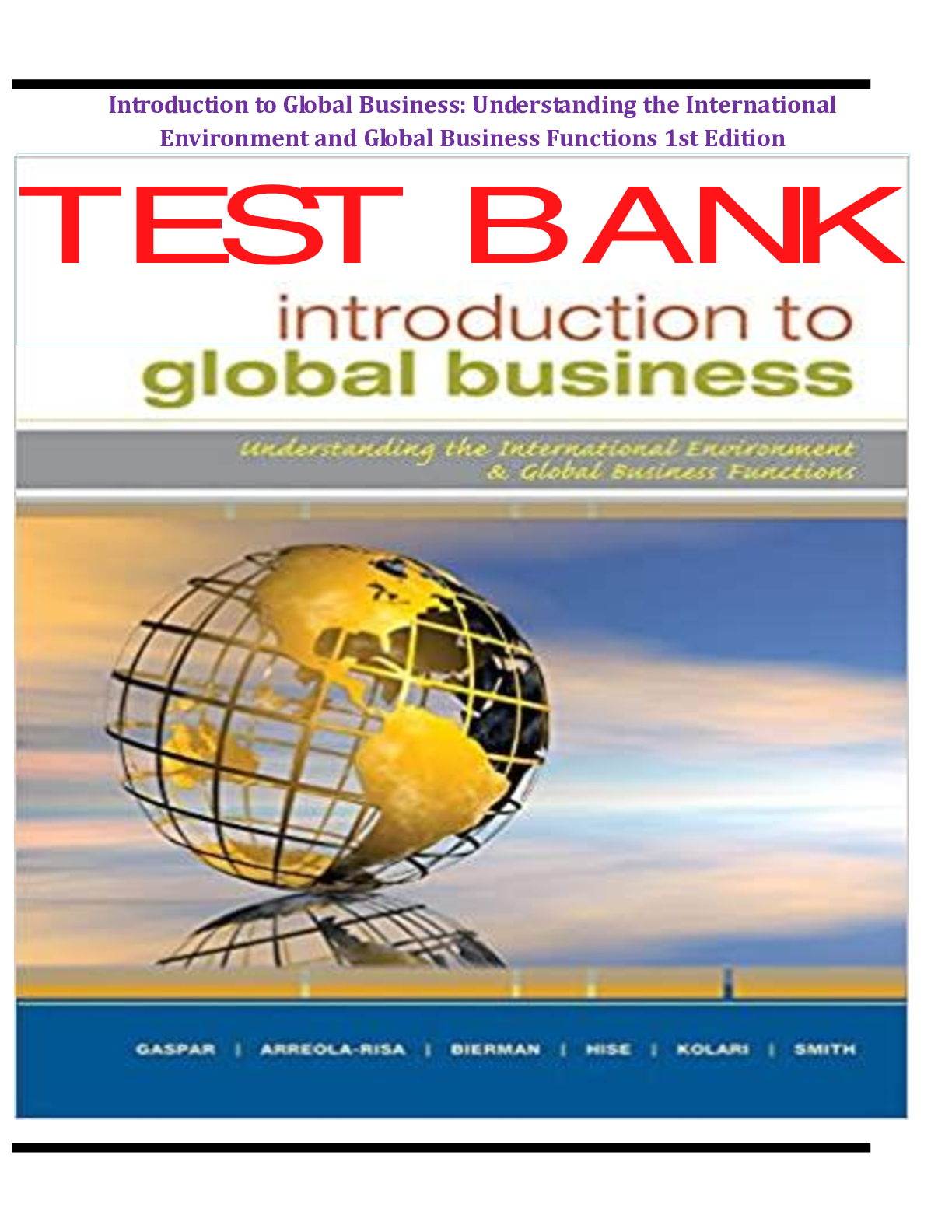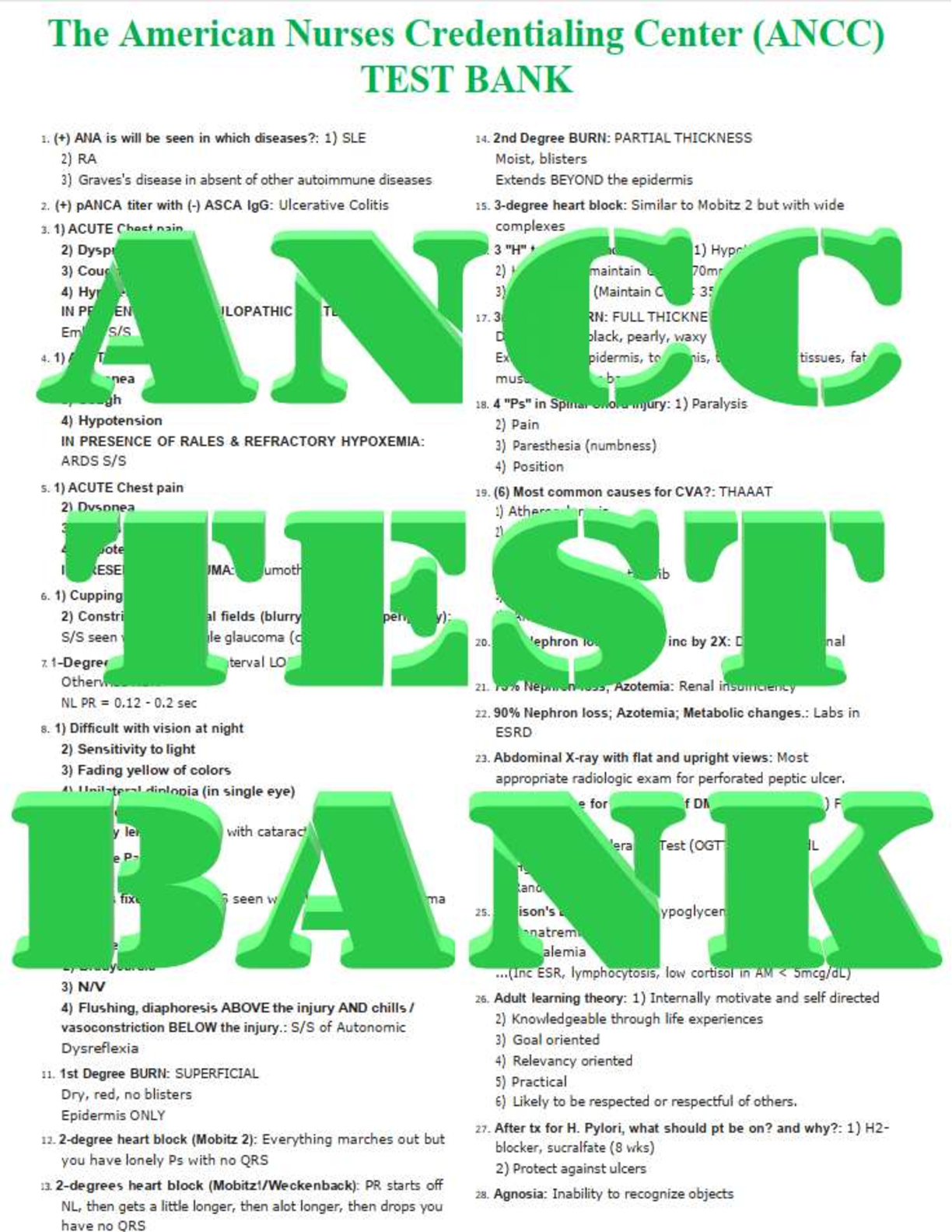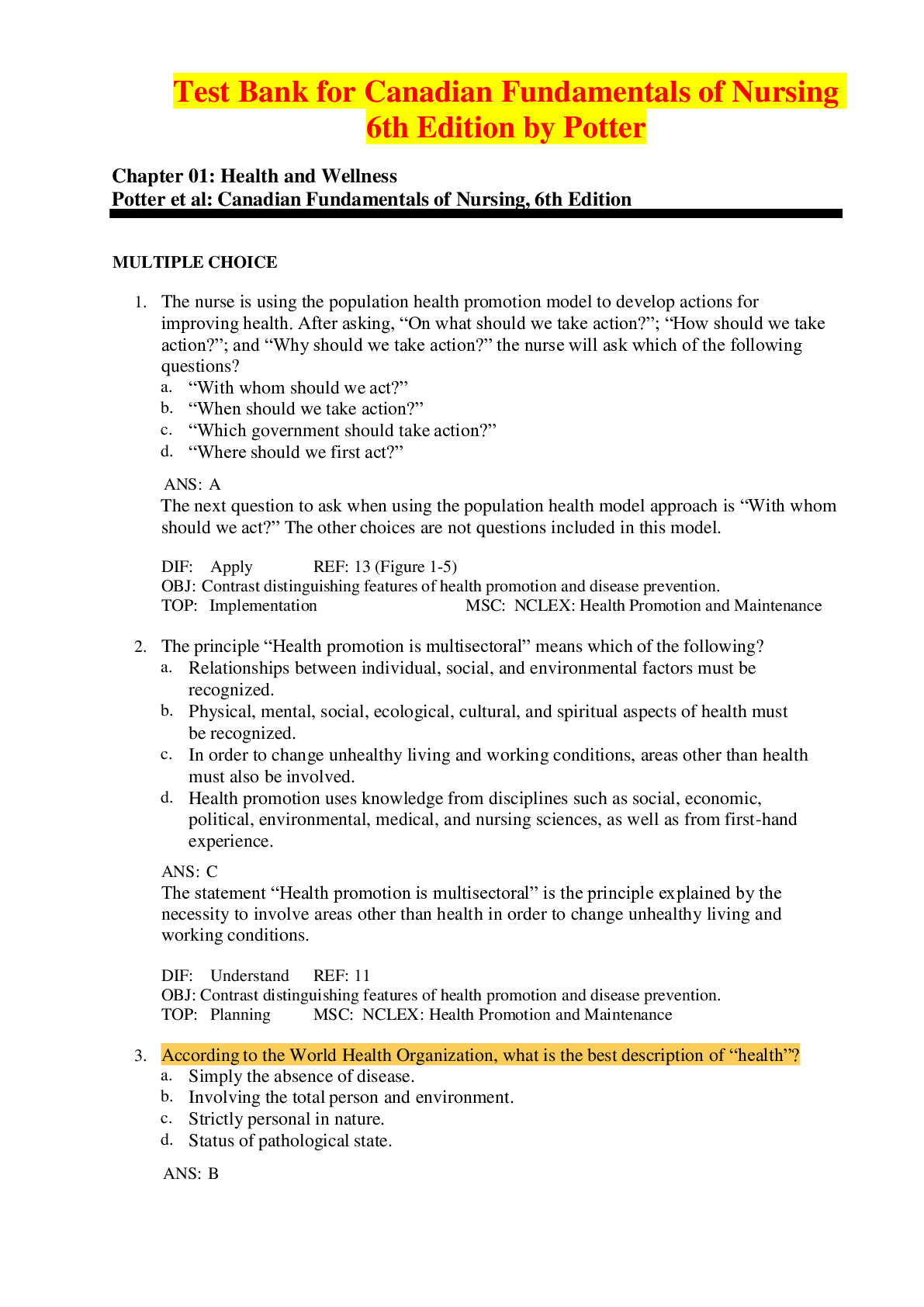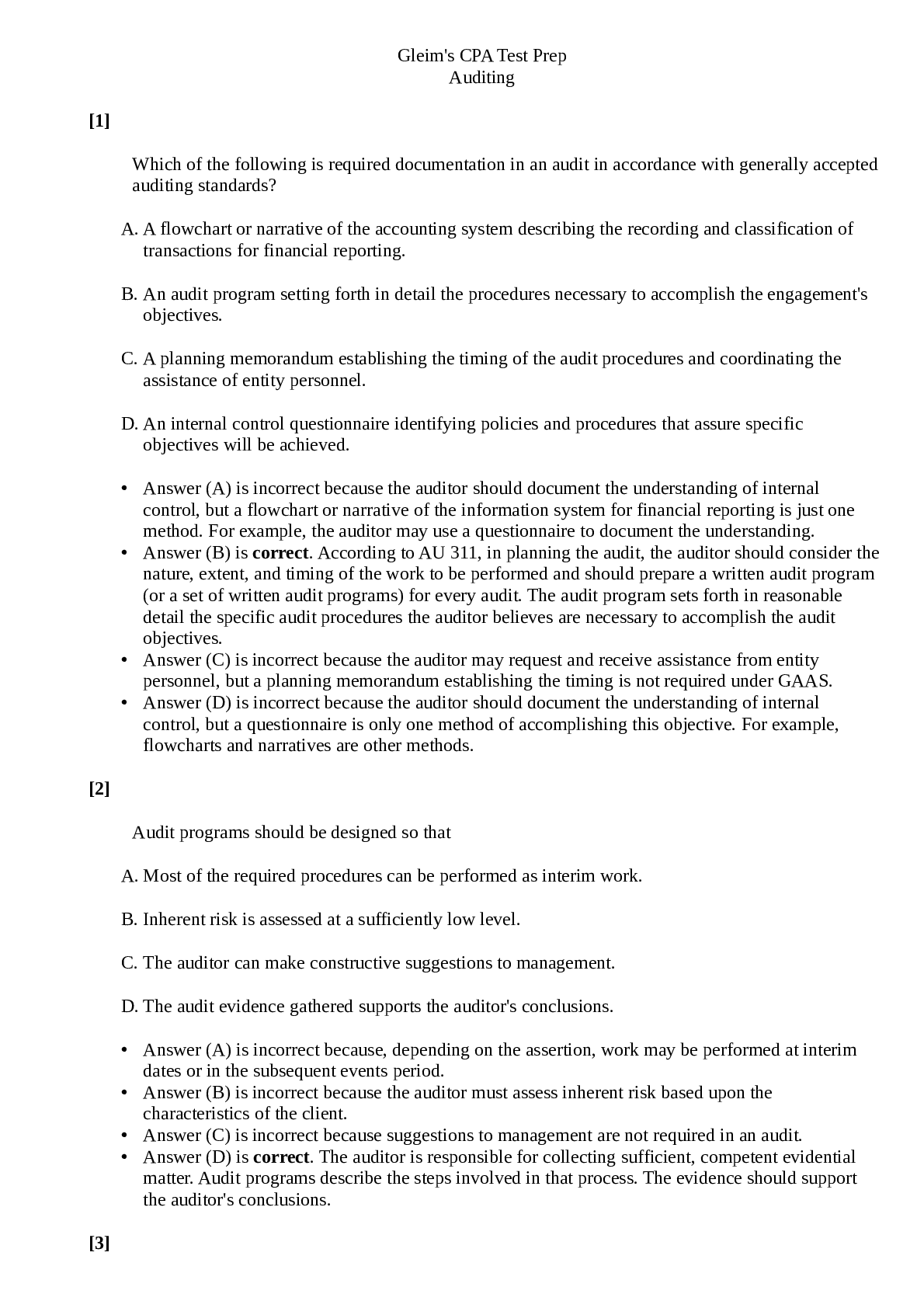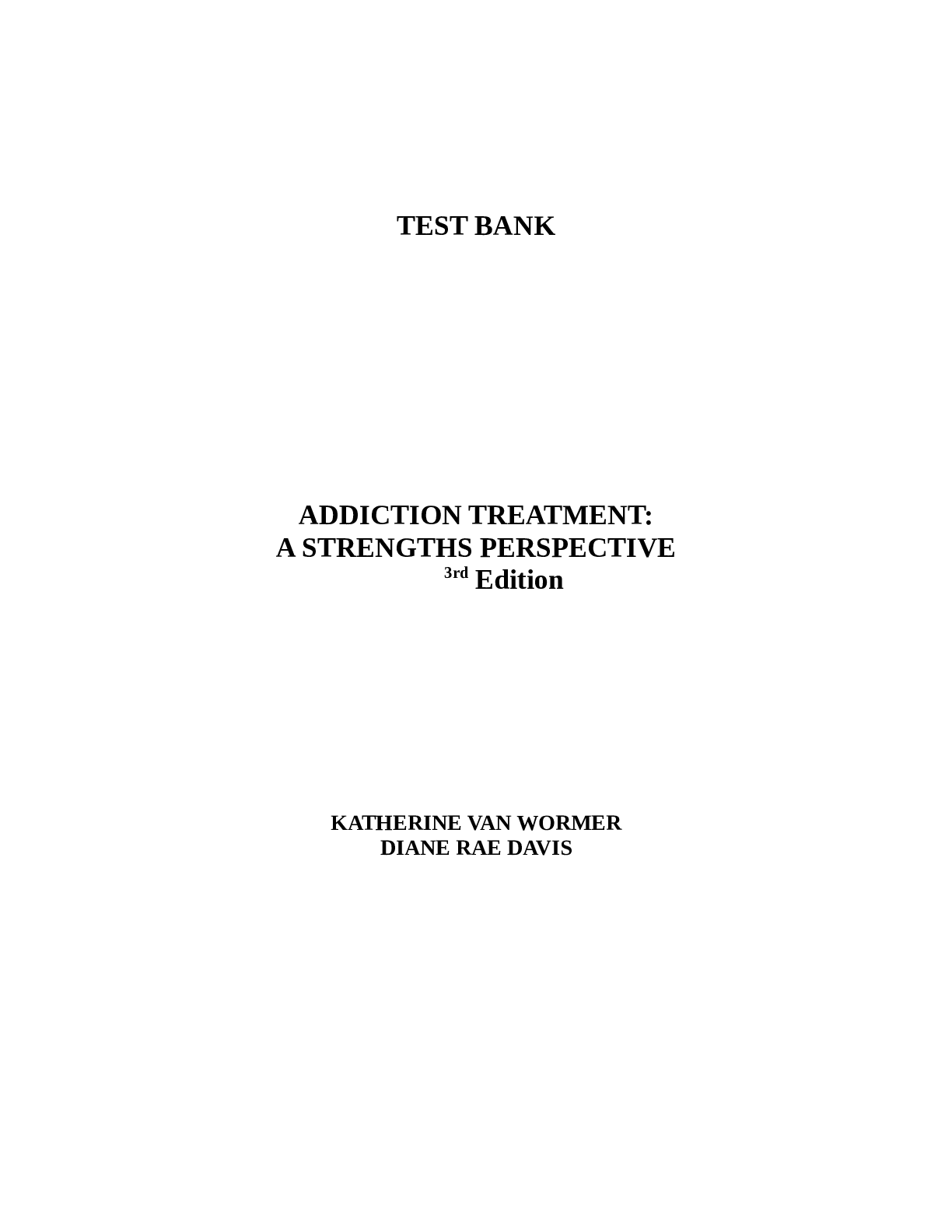Operations Management > TEST BANK > Test Bank For Principles of Operations Management, 8/E 8th Edition by Jay Heizer, Barry Render_fully (All)
Test Bank For Principles of Operations Management, 8/E 8th Edition by Jay Heizer, Barry Render_fully covered_ Ace on your studies
Document Content and Description Below
Test Bank For Principles of Operations Management, 8/E 8th Edition by Jay Heizer, CHAPTER 1: OPERATIONS AND PRODUCTIVITY TRUE/FALSE 1. Some of the operations-related activities of Hard Rock Caf... é include designing meals and analyzing them for ingredient cost and labor requirements. True (Global company profile, easy) 2. The production process at Hard Rock Café is limited to meal preparation and serving customers. False (Global company profile, easy) 3. All organizations, including service firms such as banks and hospitals, have a production function. True (What is operations management? moderate) 4. Operations management is the set of activities that create value in the form of goods and services by transforming inputs into outputs. True (What is operations management? easy) 5. An example of a "hidden" production function is money transfers at banks. True (What is operations management? moderate) 6. One reason to study operations management is to learn how people organize themselves for productive enterprise. True (Why study OM, easy) 7. The operations manager performs the management activities of planning, organizing, staffing, leading, and controlling of the OM function. True (What operations managers do, easy) 8. "How much inventory of this item should we have?" is within the critical decision area of quality management. False (What operations managers do, easy) 9. In order to have a career in operations management, one must have a degree in statistics or quantitative methods. False (What operations managers do, easy) 10. Henry Ford is known as the Father of Scientific Management. False (The heritage of operations management, easy) 11. Shewhart’s contributions to operations management came during the Scientific Management Era. False (The heritage of operations management, easy) 12. Students wanting to pursue a career in operations management will find multidisciplinary knowledge beneficial. True (Where are the OM jobs? easy) 13. Customer interaction is often high for manufacturing processes, but low for services. False (Operations in the service sector, moderate) 14. Productivity is more difficult to improve in the service sector. True (The productivity challenge, moderate) 15. Manufacturing now constitutes the largest economic sector in postindustrial societies. False (Operations in the service sector, moderate) 16. In the past half-century, the number of people employed in manufacturing has risen only modestly, but each manufacturing employee is manufacturing about 20 times as much. True (Operations in the service sector, easy) 17. A knowledge society is one that has migrated from work based on knowledge to one based on manual work. False (The productivity challenge, easy) 18. Productivity is the total value of all inputs to the transformation process divided by the total value of the outputs produced. False (The productivity challenge, easy) 19. Measuring the impact of a capital acquisition on productivity is an example of multi-factor productivity. False (The productivity challenge, moderate) 20. Ethical and social dilemmas arise because stakeholders of a business have conflicting perspectives. True (Ethics and social responsibility, easy) MULTIPLE CHOICE 21. At Hard Rock Café, tasks that reflect operations or operations management include a. designing meals b. testing meals (recipes) c. analyzing meals for the cost of ingredients d. preparing employee schedules e. all of the above e (Global company profile, easy) 22. An operations task performed at Hard Rock Café is a. borrowing funds to build a new restaurant b. advertising changes in the restaurant menu c. calculating restaurant profit and loss d. preparing employee schedules e. all of the above d (Global company profile, moderate) 23. Operations management is applicable a. mostly to the service sector b. to services exclusively c. mostly to the manufacturing sector d. to all firms, whether manufacturing and service e. to the manufacturing sector exclusively d (What is operations management? moderate) 24. Which of the following are the primary functions of all organizations? a. operations, marketing, and human resources b. marketing, human resources, and finance/accounting c. sales, quality control, and operations d. marketing, operations, and finance/accounting e. research and development, finance/accounting, and purchasing d (Organizing to produce goods and services, moderate) 25. Budgeting, paying the bills, and collection of funds are activities associated with the a. management function b. control function c. finance/accounting function d. production/operations function e. staffing function c (Organizing to produce goods and services, moderate) 26. Which of the following would not be an operations function in a fast-food restaurant? a. advertising and promotion b. designing the layout of the facility c. maintaining equipment d. making hamburgers and fries e. purchasing ingredients a (Organizing to produce goods and services, moderate) 27. The marketing function's main concern is with a. producing goods or providing services b. procuring materials, supplies, and equipment c. building and maintaining a positive image d. generating the demand for the organization's products or services e. securing monetary resources d (Organizing to produce goods and services, moderate) 28. Reasons to study Operations Management include a. studying why people organize themselves for free enterprise b. knowing how goods and services are consumed c. understanding what human resource managers do d. learning about a costly part of the enterprise e. all of the above d (Why study OM? moderate) 29. Reasons to study Operations Management include learning about a. why people organize themselves for productive enterprise b. how goods and services are produced c. what operations managers do d. a costly part of the enterprise e. all of the above e (Why study OM? easy) 30. The five elements in the management process are a. plan, direct, update, lead, and supervise b. accounting/finance, marketing, operations, and management c. organize, plan, control, staff, and manage d. plan, organize, staff, lead, and control e. plan, lead, organize, manage, and control c (What do operations managers do? easy) 31. The responsibilities of the operations manager include a. planning, organizing, staffing, procuring, and reviewing b. forecasting, designing, planning, organizing, and controlling c. forecasting, designing, operating, procuring, and reviewing d. planning, organizing, staffing, leading, and controlling e. designing and operating d (What do operations managers do? easy) 32. Which of the following is not an element of the management process? a. controlling b. leading c. planning d. pricing e. staffing d (What do operations managers do? easy) 33. An operations manager is not likely to be involved in a. the design of products and services to satisfy customers' wants and needs b. the quality of products and services to satisfy customers' wants and needs c. the identification of customers' wants and needs d. work scheduling to meet the due dates promised to customers e. forecasting sales c (What do operations managers do? easy) 34. All of the following decisions fall within the scope of operations management except for a. financial analysis b. design of products and processes c. location of facilities d. quality management e. All of the above fall within the scope of operations management. a (What do operations managers do? easy) 35. The Ten Critical Decisions of Operations Management include a. Layout design b. Maintenance c. Process and capacity design d. Quality management e. all of the above e (Why study OM? easy) 36. Which of the following is not one of The Ten Critical Decisions of Operations Management? a. Layout design b. Maintenance c. Process and capacity design d. Mass customization e. Supply chain management d (Why study OM? moderate) 37. The Ten Critical Decisions of Operations Management include a. Finance/accounting b. Hiring c. Process and capacity design d. Pricing e. all of the above c (Why study OM? moderate) 38. Walter Shewhart is listed among the important people of operations management because of his contributions to a. assembly line production b. measuring the productivity in the service sector c. just-in-time inventory methods d. statistical quality control e. all of the above d (The heritage of operations management, moderate) 39. Walter Shewhart, in the _____, provided the foundations for ______ in operations management. a. 1920s; statistical sampling b. United Kingdom; mass production c. U.S. Army; logistics d. nineteenth century; interchangeable parts e. none of the above a ( The heritage of operations management, moderate) 40. Eli Whitney, in the _____, provided the foundations for ______ in operations management. a. 1920s; statistical sampling b. United Kingdom; mass production c. U.S. Army; logistics d. nineteenth century; interchangeable parts e. none of the above d (The heritage of operations management, moderate) 41. The person most responsible for popularizing interchangeable parts in manufacturing was a. Frederick Winslow Taylor b. Henry Ford c. Eli Whitney d. Whitney Houston e. Lillian Gilbreth c (The heritage of operations management, moderate) 42. The "Father of Scientific Management" is a. Henry Ford b. Frederick W. Taylor c. W. Edwards Deming d. Frank Gilbreth e. just a figure of speech, not a reference to a person b (The heritage of operations management, easy) 43. Henry Ford is noted for his contributions to a. standardization of parts b. statistical quality control c. assembly line operations d. scientific management e. time and motion studies c (The heritage of operations management, easy) 44. Who among the following is associated with contributions to quality control in operations management? a. Charles Babbage b. Henry Ford c. Frank Gilbreth d. W. Edwards Deming e. Henri Fayol d (The heritage of operations management, moderate) 45. The field of operations management is shaped by advances in which of the following fields? a. chemistry and physics b. industrial engineering and management science c. biology and anatomy d. information sciences e. all of the above e (The heritage of operations management, moderate) 46. Which of the following statements is true? a. Almost all services and almost all goods are a mixture of a service and a tangible product. b. A pure good has no tangible product component. c. A pure service has only a tangible product component. d. There is no such thing as a pure good. e. None of the above is a true statement. a (Operations in the service sector, difficult) 47. Which of the following statements is true? a. The person most responsible for initiating use of interchangeable parts in manufacturing was Eli Whitney. b. The origins of management by exception are generally credited to Frederick W. Taylor. c. The person most responsible for initiating use of interchangeable parts in manufacturing was Walter Shewhart. d. The origins of the scientific management movement are generally credited to Henry Ford. e. The person most responsible for initiating use of interchangeable parts in manufacturing was Henry Ford. a (The heritage of operations management, moderate) 48. The service industry makes up approximately what percentage of all jobs in the United States? a. 13% b. 40% c. 66% d. 77% e. 90% d (Operations in the service sector, moderate) 49. Typical differences between goods and services do not include a. cost per unit b. ability to inventory items c. timing of production and consumption d. customer interaction e. knowledge content a (Operations in the service sector, moderate) 50. Which is not true regarding differences between goods and services? a. Services are generally produced and consumed simultaneously; tangible goods are not. b. Services tend to be more knowledge-based than products. c. Services tend to have a more inconsistent product definition than goods. d. Goods tend to have higher customer interaction than services. e. None of the above is true. d (Operations in the service sector, moderate) 51. Which of the following is not a typical attribute of goods? a. output can be inventoried b. often easy to automate c. aspects of quality difficult to measure d. output can be resold e. production and consumption are separate c (Operations in the service sector, moderate) 52. Which of the following services is least likely to be unique, i.e., customized to a particular individual's needs? a. dental care b. hairdressing c. legal services d. elementary education e. computer consulting d (Operations in the service sector, moderate) 53. Which of the following is not a typical service attribute? a. intangible product b. easy to store c. customer interaction is high d. simultaneous production and consumption e. difficult to resell b (Operations in the service sector, moderate) 54. Which of the following statements concerning growth of services is true? a. Services now constitute the largest economic sector in postindustrial societies. b. The number of people employed in manufacturing has increased modestly since 1950. c. Each manufacturing employee now produces about 20 times more than in 1950 d. All of the above are true. e. None of the above is true. d (Operations in the service sector, moderate) 55. Current trends in operations management include all of the following except a. just-in-time performance b. rapid product development c. mass customization d. empowered employees e. All of the above are current trends. e (Exciting new trends in operations management, moderate) 56. Which of the following is not a current trend in operations management? a. just-in-time performance b. global focus c. supply chain partnering d. mass customization e. All of the above are current trends. e (Exciting new trends in operations management, moderate) 57. One new trend in operations management is a. global focus b. mass customization c. empowered employees d. rapid product development e. All of the above are new trends in operations management. e (Exciting new trends in operations management, moderate) 58. Which of the following statements about trends in operations management is false? a. Job specialization is giving way to empowered employees. b. Local or national focus is giving way to global focus. c. Environmentally-sensitive production is giving way to low-cost focus. d. Rapid product development is partly the result of shorter product cycles. e. All of the above statements are true. c (Exciting new trends in operations management, moderate) 59. A foundry produces circular utility access hatches (manhole covers). If 120 covers are produced in a 10-hour shift, the productivity of the line is a. 1.2 covers/hr b. 2 covers/hr c. 12 covers/hr d. 1200 covers/hr e. none of the above c (The productivity challenge, easy) 60. A foundry produces circular utility access hatches (manhole covers). Currently, 120 covers are produced in a 10-hour shift. If labor productivity can be increased by 20%, it would then be a. 14.4 covers/hr b. 24 covers/hr c. 240 valves/hr d. 1200 covers/hr e. none of the above a (The productivity challenge, moderate) 61. Gibson Valves produces cast bronze valves on an assembly line. If 1600 valves are produced in an 8-hour shift, the productivity of the line is a. 2 valves/hr b. 40 valves/hr c. 80 valves/hr d. 200 valves/hr e. 1600 valves/hr d (The productivity challenge, easy) 62. Gibson Valves produces cast bronze valves on an assembly line, currently producing 1600 valves each 8-hour shift. If the productivity is increased by 10%, it would then be a. 180 valves/hr b. 200 valves/hr c. 220 valves/hr d. 880 valves/hr e. 1760 valves/hr c (The productivity challenge, moderate) 63. Gibson Valves produces cast bronze valves on an assembly line, currently producing 1600 valves per shift. If the production is increased to 2000 valves per shift, labor productivity will increase by a. 10% b. 20% c. 25% d. 40% e. 50% c (The productivity challenge, moderate) 64. The Dulac Box plant produces 500 cypress packing boxes in two 10-hour shifts. What is the productivity of the plant? a. 25 boxes/hr b. 50 boxes/hr c. 5000 boxes/hr d. none of the above e. not enough data to determine productivity a (The productivity challenge, moderate) 65. The Dulac Box plant produces 500 cypress packing boxes in two 8-hour shifts. The use of new technology has enabled them to increase productivity by 30%. Productivity is now approximately a. 32.5 boxes/hr b. 40.6 boxes/hr c. 62.5 boxes/hr d. 81.25 boxes/hr e. 300 boxes/hr b (The productivity challenge, moderate) 66. The Dulac Box plant produces 500 cypress packing boxes in two 10-hour shifts. Due to higher demand, they have decided to operate three 8-hour shifts instead. They are now able to produce 600 boxes per day. What has happened to production? a. It has increased by 50 sets/shift. b. It has increased by 37.5 sets/hr. c. It has increased by 20%. d. It has decreased by 8.3%. e. It has decreased by 9.1%. c (The productivity challenge, moderate) 67. Productivity measurement is complicated by a. the competition's output b. the fact that precise units of measure are often unavailable c. stable quality d. the workforce size e. the type of equipment used b (The productivity challenge, moderate) 68. The total of all outputs produced by the transformation process divided by the total of the inputs is a. utilization b. greater in manufacturing than in services c. defined only for manufacturing firms d. multi-factor productivity e. none of the above d (The productivity challenge, moderate) 69. Which of the following inputs has the greatest potential to increase productivity? a. labor b. globalization c. management d. capital e. none of the above c (The productivity challenge, moderate) 70. Productivity can be improved by a. increasing inputs while holding outputs steady b. decreasing outputs while holding inputs steady c. increasing inputs and outputs in the same proportion d. decreasing inputs while holding outputs steady e. none of the above d (The productivity challenge, moderate) 71. The largest contributor to productivity increases is ________, estimated to be responsible for _____ of the annual increase. a. management; over one-half b. Mr. Deming; one-half c. labor; two-thirds d. capital; 90% e. technology; over one-half a (The productivity challenge, moderate) 72. The factor responsible for the largest portion of productivity increase in the U.S. is a. labor b. management c. capital d. all three combined; it is impossible to determine the contribution of individual factors e. none of these; most productivity increases come from investment spending b (The productivity challenge, moderate) 73. Which of the following is not true when explaining why productivity tends to be lower in the service sector than in the manufacturing sector? a. Services are typically labor intensive. b. Services are often difficult to evaluate for quality. c. Services are often an intellectual task performed by professionals. d. Services are difficult to automate. e. Service operations are typically capital intensive. e (The productivity challenge, moderate) 74. Three commonly used productivity variables are a. quality, external elements, and precise units of measure b. labor, capital, and management c. technology, raw materials, and labor d. education, diet, and social overhead e. quality, efficiency, and low cost b (The productivity challenge, moderate) 75. The service sector has lower productivity improvements than the manufacturing sector because a. the service sector uses less skilled labor than manufacturing b. the quality of output is lower in services than manufacturing c. services usually are labor intensive d. service sector productivity is hard to measure e. none of the above c (The productivity challenge, moderate) 76. Productivity tends to be more difficult to improve in the service sector because the work is a. often difficult to automate b. typically labor intensive c. frequently processed individually d. often an intellectual task performed by professionals e. all of the above e (The productivity challenge, moderate) 77. Among the ethical and social challenges facing operations managers are a. honoring community commitments b. maintaining a clean environment c. developing safe quality products d. providing a safe workplace e. all of the above e (Ethics and social responsibility, easy) 78. Among the ethical and social challenges facing operations managers are a. honoring financial commitments b. maintaining a clean environment c. developing low-cost products d. providing an efficient workplace e. all of the above b (Ethics and social responsibility, moderate) 79. Which of the following is not among the ethical and social challenges facing operations managers? a. honoring community commitments b. maintaining a clean environment c. developing safe quality products d. increasing executive pay e. providing a safe workplace d (Ethics and social responsibility, easy) 80. A business’s stakeholders, whose conflicting perspectives cause ethical and social dilemmas, include a. lenders b. suppliers c. owners d. employees e. all of the above e (Ethics and social responsibility, easy) FILL-IN-THE-BLANK 81. _____________________________ is an operations task at Hard Rock Café associated with the critical decision area "Layout design." Designing efficient layouts (Global company profile, moderate) 82. _____________________________ is the set of activities that transforms inputs into goods and services. Operations management (What is operations management? easy) 83. Marketing, Production, and _____________________________ are the three functions that all organizations must perform to create goods and services. finance/accounting (Organizing to produce goods and services, easy) 84. "Should we make or buy this component?" is an issue in the _____________________________ critical decision area. supply-chain management (What operations managers do, easy) 85. Henry Ford and _____________________________ are credited with the development of the moving assembly line. Charles Sorensen (The heritage of operations management, easy) 86. When a tangible product is not included in a service, it is called a _____________________________. pure service (Operations in the service sector, easy) 87. _____________________________ is the ability of the organization to be flexible enough to cater to the individual whims of consumers. Mass customization (Exciting new trends in operations management, moderate) 88. _____________________________ is the operations management trend that moves more decision making to the individual worker. Empowered employees (Exciting new trends in operations management, moderate) 89. ____________________________ is the total of all outputs produced by the transformation process divided by the total of the inputs. Multi-factor productivity (The productivity challenge, easy) 90. Productivity is the ratio of ____________ to _________. Using this relationship, productivity can be improved by ______________________ or _________________________. inputs, outputs; reducing inputs while holding outputs constant; increasing outputs while holding inputs constant. (The productivity challenge, moderate) SHORT ANSWER 91. List three or more operations-related tasks carried out by Hard Rock Café. Providing custom meals; designing, testing, and costing meals; acquiring, receiving , and storing supplies; recruiting and training employees; preparing employee schedules; designing efficient restaurant layouts. (Global company profile, easy) 92. List two operations-related tasks carried out by Hard Rock Café. Match each to its area of the Ten Critical Decisions. Providing custom meals—service and product design; designing, testing, and costing meals—service and product design; acquiring, receiving , and storing supplies—supply-chain management; recruiting and training employees—human resources and job design; preparing employee schedules—intermediate and short-term scheduling; designing efficient restaurant layouts—layout design. (Global company profile, moderate) 93. Define operations management. Will your definition accommodate both manufacturing and service operations? Operations management can be defined as the management of all activities directly related to the creation of goods and/or services through the transformation of inputs into outputs. (What is operations management? easy) 94. List the items that Fredrick W. Taylor believed management should be more responsible for. He believed that management should be more responsible for matching employees to the right job, providing the proper training, providing proper work methods and tools, and establishing legitimate incentives for work to be accomplished. (The heritage of operations management, moderate) 95. Operations managers should be well versed in what disciplines in order to make good decisions? Management science, information sciences, and often one of the biological or physical sciences. (The heritage of operations management, moderate) 96. Why are services typically more difficult to standardize, automate, and make efficient? Services typically require customer interaction, which makes it difficult to standardize, automate, and make efficient. (Operations in the service sector, moderate) 97. How do services differ from goods? List five ways. Pick from the following: a service is usually tangible; it is often produced and consumed simultaneously; often unique; it involves high customer interaction; product definition is inconsistent; often knowledge-based; and frequently dispersed. (Operations in the service sector, moderate) 98. Services are often knowledge-based. Provide two examples, and explain why they are knowledge-based. Answer will vary, but the textbook used education, medical, and legal services. (Operations in the service sector, moderate) 99. Why are organizations changing from batch (large) shipments to just-in-time (JIT) shipments? Organizations are switching to JIT shipments because inventory requires a large financial investment, and impedes the responsiveness to changes in the marketplace. (Exciting new trends in operations management, moderate) 100. Why are organizations becoming more global? Organizations are becoming more global with the decline in the cost of communication and transportation. Additionally, resources--material, talent, and labor--are also becoming more global. (Exciting new trends in operations management) 101. List the three productivity variables used in the text. What other variables are possible? Discuss, and provide an example. The three common variables are labor, capital, and management. The text also uses "material" and "miscellaneous" in its examples. Any resource could be named as a productivity variable. (The productivity challenge, moderate) 102. What is a knowledge society? A knowledge society is one in which much of the labor force has migrated from manual work to work based on knowledge. (The productivity challenge, moderate) 103. Why are operations managers faced with ethical and social challenges? Businesses have diverse stakeholders, which include owners, employees, lenders, and distributors. These stakeholders hold conflicting perspectives. (Ethics and social responsibility, easy) 104. What are some of the ethical and social challenges faced by operations managers? Developing safe quality products; maintaining a clean environment; providing a safe workplace; honoring community commitments. (Ethics and social responsibility, easy) 105. As the administrative manager in a law office, you have been asked to develop a system for evaluating the productivity of the 15 lawyers in the office. What difficulties are you going to have in doing this, and how are you going to overcome them? Productivity measurers for a law office are difficult. Simple criteria, like number of cases processed, fail to consider complexity of the case. Even counting wins is difficult, as many cases are settled with some sort of compromise. External elements such as the quality of the opposing counsel and the tenacity of the opposition also make counting look rather silly. Categories of cases can help—(i.e., uncontested divorce, no personal injury auto case, etc.) However, many firms end up counting hours billed. This in turns leads to other problems, as noted by the number of false billing cases. (The productivity challenge, moderate) PROBLEMS 106. Susan has a part-time "cottage industry" producing seasonal plywood yard ornaments for resale at local craft fairs and bazaars. She currently works 8 hours per day to produce 16 ornaments. a. What is her productivity? b. She thinks that by redesigning the ornaments and switching from use of a wood glue to a hot-glue gun she can increase her total production to 20 ornaments per day. What is her new productivity? c. What is her percentage increase in productivity? a. 16 ornaments/8 hours = 2 ornaments/hour b. 20 ornaments/8 hours = 2.5 ornaments/hour c. Change in productivity = 0.5 ornaments/hour; percent change = 0.5/2= 25% (The productivity challenge, moderate) 107. A firm cleans chemical tank cars in the Bay St. Louis area. With standard equipment, the firm typically cleaned 70 chemical tank cars per month. They utilized 10 gallons of solvent, and two employees worked 20 days per month, 8 hours a day. The company decided to switch to a larger cleaning machine. Last April, they cleaned 60 tank cars in only 15 days. They utilized 12 gallons of solvent, and the two employees worked 6 hours a day. 1. What was their productivity with the standard equipment? 2. What is their productivity with the larger machine? 3. What is the change in productivity? Resource Standard Equipment Larger Machine Percent Change Solvent Labor (The productivity challenge, moderate) 108. The Dulac Box plant produces wooden packing boxes to be used in the local seafood industry. Current operations allow the company to make 500 boxes per day, in two 8-hour shifts (250 boxes per shift). The company has introduced some small changes in equipment, and conducted appropriate job training, so that production levels have risen to 300 boxes per shift. These changes did not require any change in the amount of capital spending or energy use. What is the firm's new labor productivity? 600 boxes per day / 16 hours = 37.5 boxes per hour 109. Mark's Ceramics spent $4000 on a new kiln last year, in the belief that it would cut energy usage 25% over the old kiln. This kiln is an oven that turns "greenware" into finished pottery. Mark is concerned that the new kiln requires extra labor hours for its operation. Mark wants to check the energy savings of the new oven, and also to look over other measures of their productivity to see if the change really was beneficial. Mark has the following data to work with: Last Year This Year Production (finished units) 4000 4000 Greenware (pounds) 5000 5000 Labor (hrs) 350 375 Capital ($) 15000 19000 Energy (kWh) 3000 2600 Were the modifications beneficial? The energy modifications did not generate the expected savings; labor and capital productivity decreased. (The productivity challenge, moderate) Resource Last Year This Year Change Pct. Change Labor 4000 / 350 = 11.43 4000 / 375 = 10.67 -0.76 -6.7% Capital 4000 / 15000 = 0.27 4000 / 19000 = .21 -0.06 -22.2% Energy 4000 / 3000 = 1.33 4000 / 2600 = 1.54 0.21 15.4% 110. Martin Manufacturing has implemented several programs to improve its productivity. They have asked you to evaluate the firm's productivity by comparing this year's performance with last year's. The following data are available: Last Year This Year Output 10,500 units 12,100 units Labor Hours 12,000 13,200 Utilities $7,600 $8,250 Capital $83,000 $88,000 Has Martin Manufacturing improved its productivity during the past year? Productivity improved in all three categories this year; utilities showed the greatest increase, and labor the least. (The productivity challenge, moderate) Resource Last Year This Year Change Pct. Change Labor 10500 / 12000 = 0.88 12100 / 13200 = 0.92 0.04 4.8% Capital 10500 / 7600 = 1.38 12100 / 8250 = 1.47 0.09 6.2% Energy 10500 / 83000 = 0.13 12100 / 88000 = 0.14 0.01 8.7% 111. Felicien grows mirlitons (that's Cajun for Chayote squash) in his 100 by 100 foot garden. He then sells the crop at the local farmers' market. Two summers ago, he was able to produce and sell 1200 pounds of mirlitons. Last summer, he tried a new fertilizer that promised a 50% increase in yield. He harvested 1900 pounds. Did the fertilizer live up to its promise? Since the productivity gain was 58.3%, not 50%, the fertilizer was at least as good as advertised. (The productivity challenge, moderate) Two summers ago Last summer Change 1200 ÷ 10,000 = .12 lbs/sq. ft 1900 ÷ 10,000 = .19 lbs/sq. ft (.19 - .12) ÷ .12 = 58.3% 112. The Dulac Box plant produces wooden packing boxes to be used in the local seafood industry. Current operations allow the company to make 500 boxes per day, in two 8-hour shifts (250 boxes per shift). The company has introduced some moderate changes in equipment, and conducted appropriate job training, so that production levels have risen to 300 boxes per shift. Labor costs average $10 per hour for each of the 5 full-time workers on each shift. Capital costs were previously $3,000 per day, and rose to $3,200 per day with the equipment modifications. Energy costs were unchanged by the modifications, at $400 per day. What is the firm's multifactor productivity before and after the changes? MFP before: 500 boxes / ($10x5x16 + $3000 + $400) = 500 / 4200 = 0.119 boxes/dollar MFP after: 600 boxes / ($10x5x16 + $3200 + $400) = 600 / 4400 = 0.136 boxes/dollar (The productivity challenge, moderate) 113. Gibson Products produces cast bronze valves for use in offshore oil platforms. Currently, Gibson produces 1600 valves per day. The 20 workers at Gibson work from 7 a.m. until 4 p.m., with 30 minutes off for lunch and a 15 minute break during the morning work session and another at the afternoon work session. Gibson is in a competitive industry, and needs to increase productivity to stay competitive. They feel that a 20 percent increase is needed. Gibson's management believes that the 20 percent increase will not be possible without a change in working conditions, so they change work hours. The new schedule calls on workers to work from 7:30 a.m. until 4:30 p.m., during which workers can take one hour off at any time of their choosing. Obviously, the number of paid hours is the same as before, but production increases, perhaps because workers are given a bit more control over their workday. After this change, valve production increased to 1800 units per day. a. Calculate labor productivity for the initial situation b. Calculate labor productivity for the hypothetical 20 percent increase c. What is the productivity after the change in work rules? d. Write a short paragraph analyzing these results. (a) Workers are active for eight hours per day; labor productivity is 10 valves/hour (b) Productivity rises by 20 percent, to 12 valves/hour; output will be 12x8x20 = 1920 (c) New productivity is 1800 / (20 x 8) = 11.25 valves/hour (d) Gibson did not gain the desired 20 percent increase in productivity, but they did gain over ten percent, without extra equipment or energy, and without increasing the wage bill. (The productivity challenge, moderate) ***************************CONTINUED************************ [Show More]
Last updated: 1 year ago
Preview 1 out of 597 pages
Instant download

Buy this document to get the full access instantly
Instant Download Access after purchase
Add to cartInstant download
Reviews( 0 )
Document information
Connected school, study & course
About the document
Uploaded On
Nov 04, 2021
Number of pages
597
Written in
Additional information
This document has been written for:
Uploaded
Nov 04, 2021
Downloads
0
Views
313

